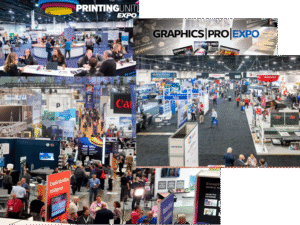 The sign and vinyl installation sector continues to transform at pace, shaped by pressures for sustainability, efficiency, and digital integration. We decided to summarize what’s been changed in the current year as how the major currents reshaping the playing field for installers, as we are, and shop owners (as you asked for) in 2025.
The sign and vinyl installation sector continues to transform at pace, shaped by pressures for sustainability, efficiency, and digital integration. We decided to summarize what’s been changed in the current year as how the major currents reshaping the playing field for installers, as we are, and shop owners (as you asked for) in 2025.
Materials & Substrates
Soft Signage & Textile Dominance
Fabric-based solutions—particularly silicone-edge graphics (SEG), tensioned textile systems, and block-out fabrics—are no longer niche. They are now front-line options in retail, events, and architectural graphics because they are lightweight, lower-risk in handling, faster to install, and more premium in finish. Increasingly, brands design with change in mind—textile graphics make refresh cycles smoother and allow for modular reuse.
Eco-Conscious & Recyclable Substrates
Sustainability is no longer an afterthought—it’s a procurement requirement. Clients are demanding materials with recyclability, minimal waste, and transparent life-cycle credentials. This includes:
- PVC-free or low-VOC films
- Substrates incorporating post-consumer recycled content
- Foam-core alternatives (foam-free or recyclable foams)
- Paper-based backlit films
- Reusable graphic systems built for modular swaps
Because of this, sign shops, with whom we have deals, are being pushed to stratify their “green line” offerings to propose to customers on the total cost-of-ownership and environmental footprint differences.
Protective & Specialty Finishes
Durability matters more than ever, particularly in high-traffic, outdoor, or transit environments. Overlaminates now often carry anti-graffiti, anti-scratch, and enhanced UV filters. These protective layers reduce maintenance, extend life cycles, and mitigate callbacks on exterior installations—effectively becoming a value-add. Additionally, textured finishes (e.g., raised printing, layered effects) and tactile embossing are gaining traction as brands seek more sensory, premium signage.
Printing, Workflow & Hardware
Hybrid & Advanced Printing Platforms
Printers that can seamlessly handle both textile and rigid substrates are increasingly critical. UV/LED, latex, and advanced resin-based systems continue to push forward in speed, durability, and reduced VOC emissions. Moreover, aqueous printers (with wide-substrate, specialty media support) are making inroads into signage environments—especially for boutique, artistic, and interior graphics.
Automation, AI & Smarter Workflows
Manual handoffs are being squeezed out. Workflow automation—spanning quoting, nesting, color management, order orchestration, and MIS integration—is becoming essential to hit tight margins. Businesses report that automation cuts errors, streamlines throughput, and frees staff for higher-level tasks. On the design side, AI-assisted tools enable rapid mockups, variable graphics, background removal, and layout adaptation across different formats. The result: faster front-end design-to-production cycles.
Specialty Media & Niche Materials
There’s rising demand for unique surfaces—Washi, textured fabrics, thick fine-art papers, translucent films, and experimental substrates. Printers that support a wide gamut of thicknesses and weights (with flexible feed paths and adaptable tension control) will have an advantage.
Installation & Application
Smarter Adhesives & Tapes
Adhesive systems are getting more sophisticated. Repositionable adhesives (for pop-ups or seasonal campaigns), high-bond acrylics (for outdoor permanence), and specialty tapes for seam sealing and bridging are increasingly common. These options help reduce installation errors and damage. Pre-testing adhesives on-site (rather than assuming) is becoming a non-negotiable best practice.
Modular & Tool-Free Systems
Retail and experiential environments are migrating toward plug-and-play, tool-free systems: magnetic mounting panels, snap-in frames, rail systems, and modular kiosks. These systems enable overnight campaign changes and minimize waste—making refreshes fast, clean, and cost-effective.
Digital + Physical Hybrid Approaches
Installers are increasingly integrating augmented reality (AR) alignment tools, QR-augmented signage, and sensor-triggered LED displays. Physical signs are becoming part of hybrid systems that combine static form and dynamic content.
Key Applications & Growth Areas
Vehicle Wraps, PPF & Mobility Surfaces
The market for vehicle graphics remains vibrant. Trends include holographic effects, satin/soft-touch films, color-shift finishes, and custom textured wraps. Combining wraps with paint protection film (PPF) is more common, so films that are easier to align and self-heal are in demand. Additionally, new mobility surfaces (e-scooters, autonomous bots, smart city installations) are opening adjacencies for wrap and graphic providers.
Experiential & Immersive Spaces
Brands are investing in immersive environmental graphics—360° image wraps, walk-through tunnels, and hybrid AR/print activations. Signage is part of a narrative, not just a backdrop.
Retail & POP Displays
Point-of-purchase and experiential props are evolving: layered dimensional displays, sculptural panels, LED integration, and mix-material installations are more common. Retail spaces demand aesthetics that photograph well for social media shareability, so signage is now part of the content strategy.
Wayfinding, ADA & Tactile Signage
Interest in photopolymer signage, high-contrast typography, and ADA-compliant designs continues to grow. The tactile and dimensional utility of signage is being re-emphasized in public spaces and commercial environments.
Traditional + Digital Integration
Traditional signage isn’t disappearing. Rather, it’s being reshaped—often used in tandem with digital displays. Static signs are being enhanced with dynamic overlays, sensor-driven content, and remotely updated messaging.
Strategic Actions & Business Tactics
 Those are our advices for fellow installer teams across USA and Canada:
Those are our advices for fellow installer teams across USA and Canada:
Upskill Strategically: Train your team in fabric tensioning, frame systems (SEG), hybrid installs (print + digital), and advanced adhesive handling. These skills differentiate your shop in a crowded market.
Run Adhesive Trials Early: Before committing to a full installation, test adhesives on-site. Calibrate the right adhesive for surface type, duration, and environment to reduce on-site failure or damage.
Package Sustainability Transparently: Offer a “green tier” option explicitly in your proposals. Highlight lifecycle benefits, waste reduction savings, and environmental certifications to appeal to eco-driven clients.
Invest in Assistive Tools: If you handle large panels regularly and have enough budget, a vacuum lifter, motorized scaffold, or robotic applicator can pay off quickly in labor savings and reduced risk.
Embed Protective Laminates: Factor protective overlaminates into quotes for exterior or high-wear applications. They often reduce callbacks and improve client satisfaction.
Adopt Smarter Workflow Tools: Implement automation systems for quote-to-production, color management, job tracking, and waste optimization. Use AI-assisted layout and asset-generation tools to speed front-end work.
Diversify Into Hybrid & Immersive Offerings: Don’t limit yourself to static signage. Expand into LED/interactive signage, structured experiential installs, and hybrid digital-physical projects. These areas often command premium pricing.
Monitor Margins & Trends: Stay current with raw material costs, substrate innovations, and client behavior. The industry is volatile—pay attention to supply chain shifts, pricing pressure, and consolidations.

